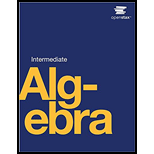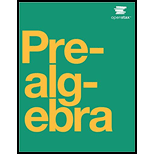Problem 481RE: In the following exercises, simplify. 481. a. 225 b. 16 Problem 482RE: In the following exercises, simplify. 482. a. 169 b. 8 Problem 483RE: In the following exercises, simplify. 483. a. 83 b. 814 c. 2435 Problem 484RE: In the following exercises, simplify. 484. a. 5123 b. 814 c. 15 Problem 485RE: In the following exercises, estimate each root between two consecutive whole numbers. 485. a. 68 b.... Problem 486RE: In the following exercises, approximate each root and round to two decimal places. 486. a. 37 b. 843... Problem 487RE: In the following exercises, simplify using absolute values as necessary. 487. a. a33 b. b77 Problem 488RE: In the following exercises, simplify using absolute values as necessary. 488. a. a14 b. w24 Problem 489RE: In the following exercises, simplify using absolute values as necessary. 489. a. m84 b. n205 Problem 490RE: In the following exercises, simplify using absolute values as necessary. 490. a. 121m20 b. 64a2 Problem 491RE: In the following exercises, simplify using absolute values as necessary. 491. a. 216a63 b. 32b205 Problem 492RE: In the following exercises, simplify using absolute values as necessary. 492. a. 144x2y2 b. 169w8y10... Problem 493RE: In the following exercises, use the Product Property to simplify radical expressions. 493. 125 Problem 494RE: In the following exercises, use the Product Property to simplify radical expressions. 494. 675 Problem 495RE: In the following exercises, use the Product Property to simplify radical expressions. 495. a. 6253... Problem 496RE: In the following exercises, simplify using absolute value signs as needed. 496. a. a23 b. b83 c.... Problem 497RE: In the following exercises, simplify using absolute value signs as needed. 497. a. 80s15 b. 96a75 c.... Problem 498RE: In the following exercises, simplify using absolute value signs as needed. 498. a. 96r3s3 b. 80x7y63... Problem 499RE: In the following exercises, simplify using absolute value signs as needed. 499. a. 325 b. 18 Problem 500RE: In the following exercises, simplify using absolute value signs as needed. 500. a. 8+96 b. 2+402 Problem 501RE: In the following exercise, use the Quotient Property to simplify square roots. 501. a. 7298 b. 24813... Problem 502RE: In the following exercise, use the Quotient Property to simplify square roots. 502. a. y4y8 b. u 21u... Problem 503RE: In the following exercise, use the Quotient Property to simplify square roots. 503. 300m564 Problem 504RE: In the following exercise, use the Quotient Property to simplify square roots. 504. a. 28p7q2 b.... Problem 505RE: In the following exercise, use the Quotient Property to simplify square roots. 505. a. 27p2q108p4q3... Problem 506RE: In the following exercise, use the Quotient Property to simplify square roots. 506. a. 180q55q b.... Problem 507RE: In the following exercises, write as a radical expression. 507. a. r12 b. s13 c. t14 Problem 508RE: In the following exercises, write with a rational exponent. 508. a. 21p b. 8q4 c. 436r6 Problem 509RE: In the following exercises, simplify. 509. a. 62514 b. 24315 c. 3215 Problem 510RE: In the following exercises, simplify. 510. a. (1,000)13 b. 1,00013 c. (1,000)13 Problem 511RE: In the following exercises, simplify. 511. a. (32)15 b. (243)15 c. 12513 Problem 512RE: In the following exercises, write with a rational exponent. 512. a. r74 b. ( 2pq5)3 c. ( 12m 7n )34 Problem 513RE: In the following exercises, simplify. 513. a. 2532 b. 932 c. (64)23 Problem 514RE: In the following exercises, simplify. 514. a. 6432 b. 6432 c. (64)32 Problem 515RE: In the following exercises, simplify. 515. a. 652612 b. (b 15)35 c. w27w97 Problem 516RE: In the following exercises, simplify. 516. a. a34a14a 104 b. ( 27 b 2 3 c 5 2 b 7 3 c 1 2 )13 Problem 517RE: In the following exercises, simplify. 517. a. 7232 b. 7p3+2p3 c. 5x33x3 Problem 518RE: In the following exercises, simplify. 518. a. 11b511b+311b b. 811cd4+511cd4911cd4 Problem 519RE: In the following exercises, simplify. 519. a. 48+27 b. 543+1283 c. 654323204 Problem 520RE: In the following exercises, simplify. 520. a. 80c720c7 b. 2162r104+432r104 Problem 521RE: In the following exercises, simplify. 521. 375y2+8y48300y2 Problem 522RE: In the following exercises, simplify. 522. a. (56)(12) b. (2184)(94) Problem 523RE: In the following exercises, simplify. 523. a. (32x3)(718x2) b. (620a23)(216a33) Problem 524RE: In the following exercises, multiply. 524. a. 11(8+411) b. 33(93+183) Problem 525RE: In the following exercises, multiply. 525. a. (327)(547) b. (x35)(x33) Problem 526RE: In the following exercises, multiply. 526. (27511)(47+911) Problem 527RE: In the following exercises, multiply. 527. a. (4+ 11)2 b. (325)2 Problem 528RE: In the following exercises, multiply. 528. (7+10)(710) Problem 529RE: In the following exercises, multiply. 529. (3x3+2)(3x32) Problem 530RE: In the following exercises, simplify. 530. a. 4875 b. 813243 Problem 531RE: In the following exercises, simplify. 531. a. 320mn 545m 7n3 b. 16x4y2354x 2y43 Problem 532RE: In the following exercises, rationalize the denominator. 532. a. 83 b. 740 c. 82y Problem 533RE: In the following exercises, rationalize the denominator. 533. a. 1113 b. 7543 c. 33x23 Problem 534RE: In the following exercises, rationalize the denominator. 534. a. 144 b. 9324 c. 69x34 Problem 535RE: In the following exercises, simplify. 535. 726 Problem 536RE: In the following exercises, simplify. 536. 5n7 Problem 537RE: In the following exercises, simplify. 537. x+8x8 Problem 538RE: In the following exercises, solve. 538. 4x3=7 Problem 539RE: In the following exercises, solve. 539. 5x+1=3 Problem 540RE: In the following exercises, solve. 540. 4x13=3 Problem 541RE: In the following exercises, solve. 541. u3+3=u Problem 542RE: In the following exercises, solve. 542. 4x+532=5 Problem 543RE: In the following exercises, solve. 543. (8x+5)13+2=1 Problem 544RE: In the following exercises, solve. 544. y+4y+2=0 Problem 545RE: In the following exercises, solve. 545. 28r+18=2 Problem 546RE: In the following exercises, solve. 546. 10+2c=4c+16 Problem 547RE: In the following exercises, solve. 547. 2x2+9x183=x2+3x23 Problem 548RE: In the following exercises, solve. 548. r+6=r+8 Problem 549RE: In the following exercises, solve. 549. x+1x2=1 Problem 550RE: In the following exercises, solve. Round approximations to one decimal place. 550. Landscaping Reed... Problem 551RE: In the following exercises, solve. Round approximations to one decimal place. 551. Accident... Problem 552RE: In the following exercises, evaluate each function. 552. g(x)=16x+1, find a. g(4) b. g(8) Problem 553RE: In the following exercises, evaluate each function. 553. G(x)=5x1, find a. G(5) b. G(2) Problem 554RE: In the following exercises, evaluate each function. 554. h(x)=x24,3 find a. h(2) b. h(6) Problem 555RE: In the following exercises, evaluate each function. 555. For the function g(x)=44x4, find a. g(1) b.... Problem 556RE: In the following exercises, find the domain of the function and write the domain in interval... Problem 557RE: In the following exercises, find the domain of the function and write the domain in interval... Problem 558RE: In the following exercises, find the domain of the function and write the domain in interval... Problem 559RE: In the following exercises, find the domain of the function and write the domain in interval... Problem 560RE: In the following exercises, find the domain of the function graph the function use the graph to... Problem 561RE: In the following exercises, find the domain of the function graph the function use the graph to... Problem 562RE: In the following exercises, find the domain of the function graph the function use the graph to... Problem 563RE: In the following exercises, find the domain of the function graph the function use the graph to... Problem 564RE: In the following exercises, write each expression in terms of i and simplify if possible. 564. a.... Problem 565RE: In the following exercises, add or subtract. 565. 50+18 Problem 566RE: In the following exercises, add or subtract. 566. (8i)+(6+3i) Problem 567RE: In the following exercises, add or subtract. 567. (6+i)(24i) Problem 568RE: In the following exercises, add or subtract. 568. (750)(3218) Problem 569RE: In the following exercises, multiply. 569. (25i)(4+3i) Problem 570RE: In the following exercises, multiply. 570. 6i(32i) Problem 571RE: In the following exercises, multiply. 571. 416 Problem 572RE: In the following exercises, multiply. 572. (512)(3+75) Problem 573RE: In the following exercises, multiply using the Product of Binomial Squares Pattern. 573. (23i)2 Problem 574RE: In the following exercises, multiply using the Product of Complex Conjugates Pattern. 574.... Problem 575RE: In the following exercises, divide. 575. 2+i34i Problem 576RE: In the following exercises, divide. 576. 432i Problem 577RE: In the following exercises, simplify. 577. i48 Problem 578RE: In the following exercises, simplify. 578. i255 Problem 579PT: In the following exercises, simplify using absolute values as necessary. 579. 125x93 Problem 580PT: In the following exercises, simplify using absolute values as necessary. 580. 169x8y6 Problem 581PT: In the following exercises, simplify using absolute values as necessary. 581. 72x8y43 Problem 582PT: In the following exercises, simplify using absolute values as necessary. 582. 45x3y4180x5y2 Problem 583PT: In the following exercises, simplify. Assume all variables are positive. 583. a. 21614 b. 4932 Problem 584PT: In the following exercises, simplify. Assume all variables are positive. 584. 45 Problem 585PT: In the following exercises, simplify. Assume all variables are positive. 585. x14x54x34 Problem 586PT: In the following exercises, simplify. Assume all variables are positive. 586. ( 8 x 2 3 y 5 2 x 7... Problem 587PT: In the following exercises, simplify. Assume all variables are positive. 587. 48x575x5 Problem 588PT: In the following exercises, simplify. Assume all variables are positive. 588. 27x24x12+108x2 Problem 589PT: In the following exercises, simplify. Assume all variables are positive. 589. 212x536x3 Problem 590PT: In the following exercises, simplify. Assume all variables are positive. 590. 43(16363) Problem 591PT: In the following exercises, simplify. Assume all variables are positive. 591. (433)(5+23) Problem 592PT: In the following exercises, simplify. Assume all variables are positive. 592. 1283543 Problem 593PT: In the following exercises, simplify. Assume all variables are positive. 593. 245xy 445x 4y3 Problem 594PT: In the following exercises, simplify. Assume all variables are positive. 594. 153 Problem 595PT: In the following exercises, simplify. Assume all variables are positive. 595. 32+3 Problem 596PT: In the following exercises, simplify. Assume all variables are positive. 596. 49 Problem 597PT: In the following exercises, simplify. Assume all variables are positive. 597. 4i(23i) Problem 598PT: In the following exercises, simplify. Assume all variables are positive. 598. 4+i32i Problem 599PT: In the following exercises, simplify. Assume all variables are positive. 599. i172 Problem 600PT: In the following exercise, solve. 600. 2x+5+8=6 Problem 601PT: In the following exercise, solve. 601. x+5+1=x Problem 602PT: In the following exercise, solve. 602. 2x26x233=x23x+53 Problem 603PT: In the following exercise, find the domain of the function graph the function use the graph to... format_list_bulleted



 Elementary AlgebraAlgebraISBN:9780998625713Author:Lynn Marecek, MaryAnne Anthony-SmithPublisher:OpenStax - Rice University
Elementary AlgebraAlgebraISBN:9780998625713Author:Lynn Marecek, MaryAnne Anthony-SmithPublisher:OpenStax - Rice University

